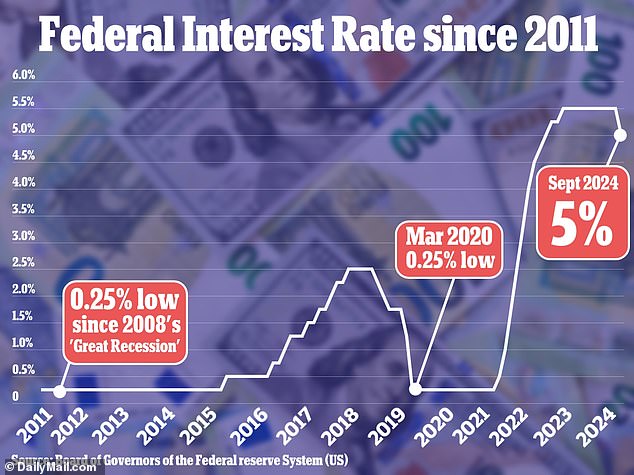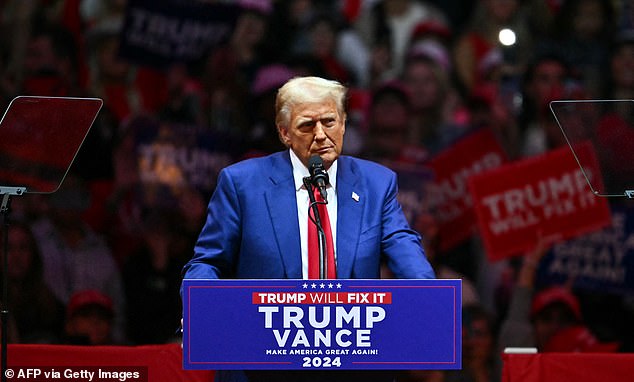Another vote this week will hit your finances more than the presidential election
As the US waits with bated breath for the results of the presidential election, another major decision will be made this week that will impact the finances of millions of Americans.
The Federal Reserve, led by Chairman Jerome Powell, will announce on Thursday whether it will cut interest rates again this year. The decision is based on a vote by the twelve members of the Fed committee.
The central bank cut interest rates in September for the first time since the early days of the Covid-19 pandemic in 2020.
It also cut borrowing costs by the largest amount in sixteen years, bringing interest rates down to between 4.75 percent and 5 percent with a cut of 50 basis points.
Investors are almost certain that the Fed will cut again at its November meeting, but it will be a more modest cut.
The Federal Reserve, led by Chairman Jerome Powell, will announce on Thursday whether it will cut interest rates again this year
According to the CME FedWatch tool, which predicts interest rate changes based on market forecasts, investors priced in a 98.8 percent chance of a default cut of 25 basis points on Thursday.
Speaking in Nashville in September, Powell said that if the economy performed as expected, the Fed would likely cut rates twice more this year.
At the time of his comments, the November and December meetings were the only two left in 2024, so economists have forecast cuts of 25 basis points each.
Policymakers could also take more such steps next year, which would make borrowing money cheaper and take the pressure off consumers’ wallets.
Although the Fed rate does not directly impact loan and credit card rates, it does have a strong influence.
Lower interest rates are also generally seen as good for businesses. If they fall, the stock market will rise, which will help boost 401(K)s that invest in major indices.
However, it may take some time before credit card companies, for example, pass on lower rates to customers. And despite falling borrowing costs, mortgage rates have actually risen in recent weeks.
Since September, several economic figures have emerged indicating that the economy is on solid footing, paving the way for an interest rate cut.
The economy comfortably exceeded expectations for job growth in September. It added 223,000 jobs and skyrocketed economists’ expectations. The unemployment rate also fell that month to 4.1 percent.
Inflation has fallen to 2.4 percent, according to the latest data from September, moving closer to the Fed’s 2 percent target.
Gross domestic product (GDP) also grew at an annual rate of 2.8 percent in the three months between July and September – slightly lower than the 3 percent annual growth rate in the second quarter.
GDP, which is a measure of all goods and services produced in that time frame, fell slightly short of economists’ expectations for the third quarter.
But According to recent estimates from the International Monetary Fund, U.S. growth this year will outpace other advanced economies such as Germany, France and the United Kingdom.
One economic data that seemed less positive was the October jobs report, released last week.

The central bank cut interest rates in September for the first time since the early days of the Covid-19 pandemic in 2020

The economy comfortably exceeded expectations for job growth in September, adding 223,000 jobs and raising economists’ expectations

Gross domestic product (GDP), a measure of all goods and services produced, grew at an annual rate of 2.8 percent between July and September
Job creation slowed last month to the weakest pace since December 2020, a Labor Department report showed on Friday.
Employers added an estimated 12,000 jobs in October, missing estimates of a 100,000 job increase by a wide margin.
But the Boeing strike and the devastating impact of Hurricanes Helene and Milton impacted the numbers, the Bureau of Labor Statistics said, and the stock market largely ignored the weak data.
Unemployment also remained unchanged in October compared to the previous month, at 4.1 percent.
“For policymakers, this report probably won’t change plans too much, but we can probably expect more rate cuts and labor market support to be on the horizon,” said Cory Stahle, economist at the Indeed Hiring Lab. Friday.
A cooling labor market and slowing price growth give the Fed “more confidence in their ability to cut rates without reigniting inflation,” said Julia Pollak, chief economist at ZipRecruiter. Business insider.
Some economists believe the U.S. economy has already experienced a rare “soft landing,” bringing runaway inflation under control without pushing the economy into recession.

Some economists believe the U.S. economy has already experienced a rare “soft landing,” bringing runaway inflation under control without pushing the economy into recession.

Trump has threatened to interfere with the Fed’s normally independent interest rate decisions if he becomes president
While it may still be unclear who won Thursday’s presidential election, Powell will announce the Fed’s decision regardless.
He has repeatedly told reporters that politics remains separate from central bank decisions.
The Fed’s future actions could become more uncertain once a new president and Congress take office in January, especially if Donald Trump wins a second term.
The former president’s proposals to impose tariffs on all imports and trigger mass deportations of illegal immigrants could reignite inflation, economists warn.
Higher inflation would, in turn, force the Fed to slow or halt its interest rate cuts.
Trump has also threatened to interfere with the Fed’s normally independent interest rate decisions if he becomes president.
“I think the president should at least have a say in that,” he said during his campaign cycle.
“In my case, I made a lot of money, I was very successful, and I think I have better instincts than, in many cases, people who would be at the Federal Reserve, or the chairman.”
